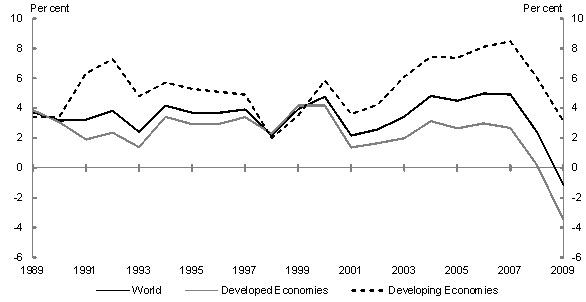During the global financial crisis, the world economy went through its worst recession since the Great Depression in the 1930s. No economy was immune to the crisis. Global GDP contracted by 1.1 per cent in 2009—the first annual contraction in six decades. Advanced economies collectively contracted by 3.3 per cent in 2009, while growth in the emerging economies slowed to 3.1 per cent (see Chart 1).
Chart 1: Real GDP growth for the world, and advanced and emerging countries

Source: IMF 1989-2009.
China entered the global financial crisis with a booming economy and macroeconomic policy was set to slow activity. At the Central Government's Economic Work Conference at the end of 2007, the Chinese Government was focusing on fighting inflation and preventing the economy from overheating. With China's economic cycle moving out of step with that of the USA, there was a growing debate about how far the Chinese economy had decoupled from the USA economy.
Arguments about decoupling were based on the growing trade integration in Asia, centred on China, and the large potential within the Chinese economy for domestically-driven demand. According to this argument, China and its regional trading partners increasingly represented an independent engine of growth for the world economy, less dependent on demand from the USA and the major economies of Europe. Moreover, notwithstanding the People's Bank of China's (PBoC) substantial holdings of US treasuries, China's financial sector had limited exposure to that of the USA. The counter argument was that China's growth continued to be highly dependent on final demand for exports in the advanced economies, suggesting a severe downturn in the USA and other advanced economies would have to impact the Chinese economy.
While China's relatively closed capital markets protected it from the financial fallout from the crisis, trade proved to be a key channel for transmitting the financial crisis to the Chinese economy. The growth rate of exports and imports declined in November 2008 and continued to be negative until November 2009 (see Chart 2). The USA, the EU, and Japan account for about half of China's exports. China's exports to these regions fell substantially as demand in these economies contracted.
Chart 2: China's imports and exports

Source: CEIC Data 1990-2011.
As trade declined, China's growth rate, which had averaged more than 10 per cent per year in the period prior to the crisis, declined to 6.8 per cent over the year to the fourth quarter of 2008, the lowest annual growth rate since 2003. With the deepening of the global recession, the growth rate fell further to 6.1 per cent over the year to the first quarter of 2009.
As the effects of the global financial crisis began to bite, China was forced to shift its policy focus towards maintaining economic growth. Coming from a position of strength, China had more policy ammunition than most to offset the effects of a slowing global economy.